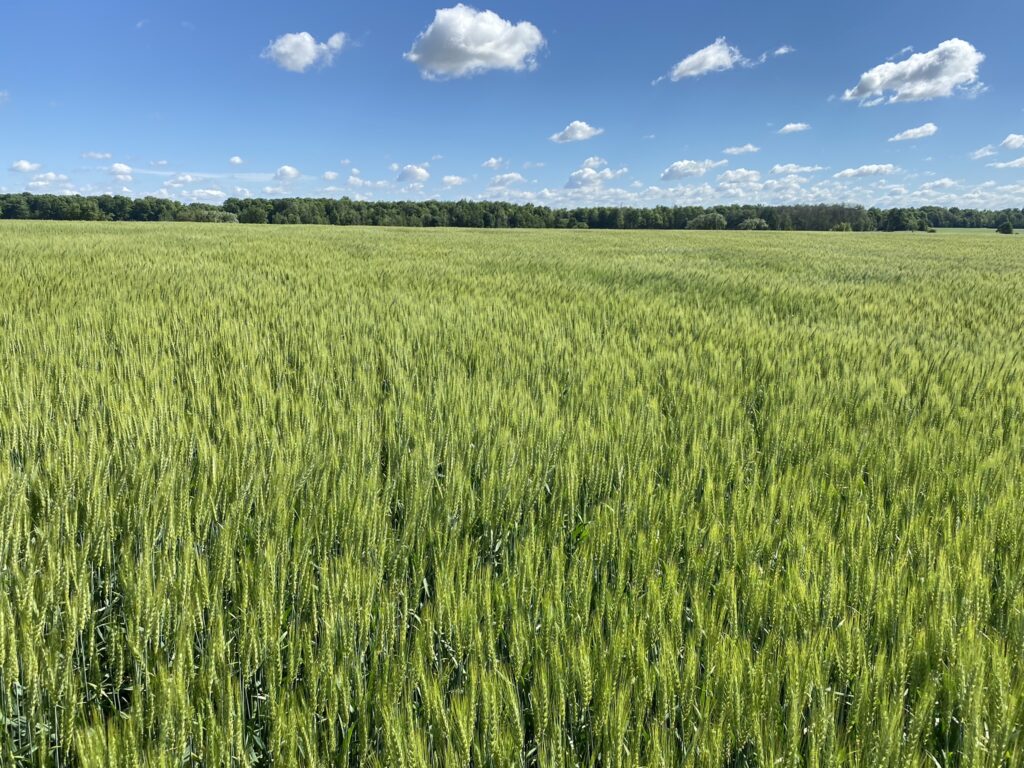Cooler than normal conditions marked the last week, with ideal temperatures for grain fill of winter wheat. A heat wave takes effect this week, with temperatures over 30 C in store for Tuesday and Wednesday.
Soybeans
Soybean growth has been slower than normal due to recent cooler temperatures. Late April planted soybeans are at the V4 stage and not yet flowering. Ideally, early planted soybeans would begin flowering by the first day of summer to maximize yield potential, though this does not occur often in this part of Ontario.
There were general reports of soybeans struggling across a wide range of soils for a variety of reasons, including tight soils due to compaction from wet soils last year. It has been difficult to make a good seedbed and achieve desired seed to soil contact in many cases. Insect damage (seed corn maggot) on soybeans seeded after first cut hay (Figure 1) was also cause for re-seeding on some fields and re-plants have occurred in fields that did not have acceptable stands due to other factors. For example, there have also been reports of poor stands in clay soils that were seeded deeper than 2 inches.

There are some regions that have had to wait until now for fit soil conditions to plant soybeans, including Glencoe, parts of Lambton County, the clay soils of west-central Elgin County, and the Hagersville area.
Corn
Corn is generally looking excellent in the area. Rows are starting to close on earlier planted corn. Later planted corn is still looking a little bit tough, but is expected to push through and improve with the heat this week. The effects of compaction and a wet fall in 2021 are showing up in some corn fields. Corn in compacted soil was reported to have significantly less root mass relative to uncompacted soil, with impacts on crop development. In some areas, drier conditions may be highlighting compaction concerns at this point in the season.
Cereals
Cracks are beginning to show in soil underneath winter wheat in areas that haven’t had significant rain recently. Wheat is still transpiring a large amount of water at this point in the season (Figure 2). Wheat maturity is slightly ahead of schedule. High temperatures in the coming days will hasten development and will not be optimal for grain fill.

Aphids are being found in some winter wheat fields, but at low densities. The primary concern with cereal aphids is vectoring of barley yellow dwarf, which is not a concern after heading. After heading, the threshold is 50 aphids per head.
Aphids have also been observed in oats. More guidance on when an insecticide application may be warranted in spring cereals prior to heading can be found here. Beneficial insects have also been observed in wheat fields and can do a relatively good job of controlling aphid populations. Consider how beneficial insects are dealing with the aphids, as registered insecticides will harm beneficials as well.
Nutrient deficiencies
Some discussion was had on the value of in-season application of granular fertilizer to address nutrient deficiencies. It was shared that if obvious potassium deficiency is observed in soybeans, it is likely worth an over-the-top application to address it, given the high density of soybean roots in the top few inches of soil. For corn, a similar approach may be warranted. Although such an approach would not be effective for phosphorus, potassium demand occurs later for corn and K is slightly more mobile in the soil. Adequate rainfall is required to move the potassium to the roots to be effective and even with good rainfall, response would not be as large as with pre-plant application.
Forages
It was re-emphasized that a large amount of forage stands did not survive winter in Elgin County. Leafhoppers are a concern from the latest round of thunderstorms and participants were encouraged to scout new seeding alfalfa after first cut.
Winter Canola
Some growers are asking questions about pre-harvest herbicide use for winter canola. More information can be found here. For those planning to double crop soybeans following winter canola harvest, they were reminded to seed at least 250,000 seeds/acre and use narrow rows. These practices help to achieve the highest number of nodes per acre with limited growing season.
AgriCorp
There has been a recent increase in re-plant and unseeded acreage claims being opened. The heavier soils of Middlesex, Essex, Kent and Lambton Counties are the main areas of claims. There are up to 800 spring re-plant claims open currently provincewide and up to 280 clients reporting unseeded acres across the province. The deadline to report inability to plant was June 15.
The deadline to report final acres for spring planting was June 20th for soybean planting in Area D and is June 30th to report final acres for spring planting of soybeans in Areas A, B and C. Spring premiums are due July 10th.